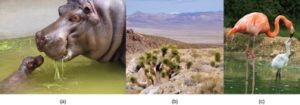Meiosis

The ability to reproduce in kind is a basic characteristic of all living things. In kind means that the offspring of any organism closely resembles its parent or parents. Hippopotamuses give birth to hippopotamus calves; Monterey pine trees produce seeds from which Monterey pine seedlings emerge; and adult flamingos lay eggs that hatch into flamingo chicks. In kind does not generally mean exactly the same. While many single-celled organisms and a few multicellular organisms can produce genetically identical clones of themselves through mitotic cell division, many single-celled organisms and most multicellular organisms reproduce regularly using another method.
Sexual reproduction is the production by parents of sex cells and the fusion of two sex cells to form a single, unique cell. In multicellular organisms, this new cell will then undergo mitotic cell divisions to develop into an adult organism. A type of cell division called meiosis leads to the cells that are part of the sexual reproductive cycle. Sexual reproduction, specifically meiosis and fertilization, introduces variation into offspring that may account for the evolutionary success of sexual reproduction. The vast majority of eukaryotic organisms can or must employ some form of meiosis and fertilization to reproduce.
References
Unless otherwise noted, images on this page are licensed under CC-BY 4.0 by OpenStax.
OpenStax, Biology. OpenStax CNX. May 27, 2016 http://cnx.org/contents/s8Hh0oOc@9.10:qOUtHXNY@3/Sexual-Reproduction
OpenStax, Biology. OpenStax CNX. May 27, 2016 http://cnx.org/contents/s8Hh0oOc@9.10:1Q8z96mT@4/Meiosis
OpenStax, Biology. OpenStax CNX. May 27, 2016 http://cnx.org/contents/s8Hh0oOc@9.10:6-3MVU-j@4/Errors-in-Meiosis


Feedback/Errata